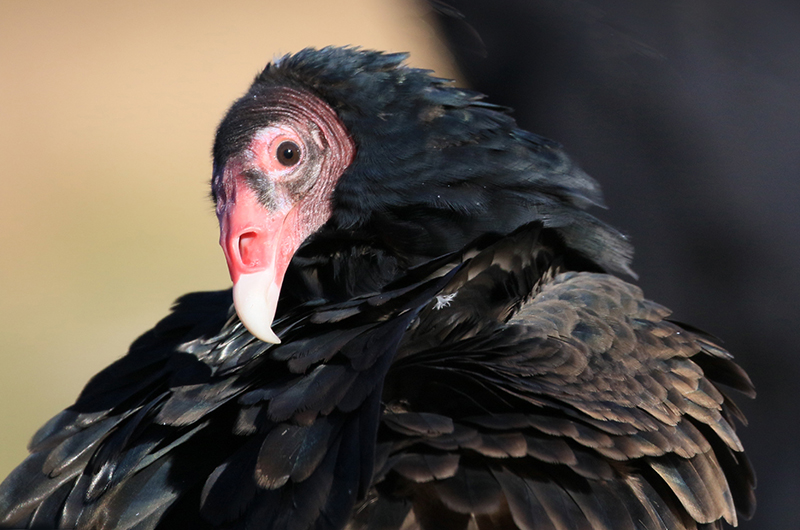Kleptoparasitism is a fancy word for a rather odd behavior: when an animal robs another animal of its food. The victim — the one that gets robbed — is often smaller and/or a less talented flyer. Bald eagles are well known for this behavior, as they will chase and harass ospreys and other species until they drop the food they caught. Perhaps this unruly behavior makes the eagle a perfect fit as our national symbol. In the seabird world, jaegers and frigatebirds are also known for this behavior.
On Jan. 27, Gus and Debbie Ben David spotted an example of this kind of theft. They found at least 40 turkey vultures roosting in the spruce trees in the cemetery adjacent to the Tisbury town hall. A pair of ravens were chasing and harassing the roosting turkey vultures until they regurgitate their most recent meal; the ravens immediately swooped in to confiscate those delectable morsels of partially-digested carrion.
The vultures have been observed recently in the late afternoons as they soar above that area. Their current roost is near their old roost behind the office of the superintendent of schools, a site that was abandoned a few years back when the spruce trees were cut down and the nearby house was renovated. If this kleptoparasitism continues, we can only wonder when this site will be abandoned, although the vultures themselves are not harmed.
Turkey vultures are found across the Island and there could be a second winter roost site somewhere up-Island. They spread out from their roosts to feed wherever they find dead animals using their keen sense of smell. Mr. Ben David has about 10 vultures visiting his yard every day, while Jeff Bernier spotted a dozen of them on State Beach near the big bridge on Jan. 21. Two have regularly been on East Beach, as spotted by Holly Mercier and Rick Dwyer from Jan. 25 to Jan. 27. Olsen Houghton and I observed maybe five vultures on Jan. 27 along the south shore of Chilmark.
Bird Sightings
Gus Ben David had other notable visitors in his yard. On Jan. 10 he had an Iceland gull, an uncommon winter visitor that we did not find in the recent Christmas Bird Count. Another species we missed on the bird count — a pine siskin — showed up at his feeders on Jan. 18. On the same day he birded Norton Point and Cape Pogue with Matt Connelly and Phil Stanton; their best birds were an immature peregrine falcon at the entrance to Norton Point, a solitary dunlin near the Gut and numbers of sanderlings, cedar waxwings and yellow-rumped warblers. An immature bald eagle was a day-tripper to his yard on Jan. 22.
A male Barrow’s goldeneye continues to hang out within a flock of common goldeneyes in Sengekontacket Pond. This species, first observed by Allan Keith on Jan. 16, was seen by Sharon Pearson and Will Broussard on Jan. 23 and again by Jeff Bernier on Jan. 25. I did not find it on the morning of Jan. 26, when the ducks all seemed to be either in Trapp’s Pond or near the boat launch ramp in Ocean Heights. My highlights included mute swans, American wigeons, mallards, black ducks, greater scaup, white-winged scoters, common eiders, buffleheads, common goldeneye, hooded and red-breasted mergansers. Luanne Johnson’s list of waterfowl from Lagoon Pond the next day is similar. I also observed small flocks of black-bellied plovers, sanderlings and dunlins as they perched and rested on the abandoned jetties near the end of the seawall in Oak Bluffs, while the next day Luanne Johnson spotted a razorbill among the same jetties.
On Jan. 27, Olsen Houghton and I birded the south shore of Chilmark and found many of the same species plus both species of loons, all three scoter species, two harlequin ducks, one long-tailed duck, one horned grebe. We also counted 355 black ducks along the south shores of Tisbury Great Pond, Black Point and Chilmark ponds. All three ponds were low because they are open to the ocean and this species appears to be more abundant when water levels are higher and the ponds are closed to the ocean. Where do they come from?
Last but not least, Don Gosselin spotted a flock of nine cedar waxwings on Jan. 26. This is a typical size of a flock of waxwings and three times as many as all birders spotted in the bad weather of the recent Christmas Bird Count.
It is getting light earlier and so this month our thoughts and ears turn to increased bird song. Please report all your sightings to birds@mvgazette.com.
Robert Culbert schedules private Guided Birding Tours and is an ecological consultant with Nature Watch, LLC living in Vineyard Haven.






Comments
Comment policy »